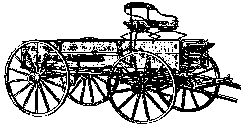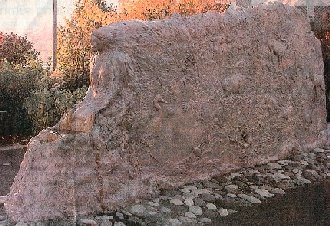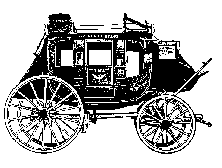8ARTICLE
Earth Mother's Future Looks Brighter
Lewiston Morning Tribune
by Heather Frye
October 2002
This page was last updated: February 1, 2010
Copyright © 2000 Larson Century Ranch, Inc. ~ All Rights Reserved
P. O. Box 1982
Clarkston, WA 99403
Telephone: 509-758-5445
FAX: 509-758-5701
The concrete Tsceminicum sculpture at the confluence of the Snake and Clearwater rivers has been damaged by weather and vadalism since it was installed in 1980. The Lewiston Lewis-Clark Bicentennial Committee received a $30,000 grant Tuesday that will pay half the price of recasting the sculpture in bronze.

Nancy Dreher hopes Earth Mother will be the first one to get a new skin.
 "The years have been the hardest on her," says the Slate Creek, Idaho, artist who created Earth Mother, and the sculpture she is a part of -- Tsceminicum -- 22 years ago for the U.S. Army Corps of Engineers.
"The years have been the hardest on her," says the Slate Creek, Idaho, artist who created Earth Mother, and the sculpture she is a part of -- Tsceminicum -- 22 years ago for the U.S. Army Corps of Engineers.
 The decades have cracked and damaged the concrete sculpture, whose name means "meeting of the waters."
The decades have cracked and damaged the concrete sculpture, whose name means "meeting of the waters."
 But after a year-long wait, members of the Lewiston Lewis-Clark Bicentennial Committee received word Tuesday that the Idaho Governor's Lewis and Clark Trail Committee will grant $30,000 to re-cast the sculpture in bronze.
But after a year-long wait, members of the Lewiston Lewis-Clark Bicentennial Committee received word Tuesday that the Idaho Governor's Lewis and Clark Trail Committee will grant $30,000 to re-cast the sculpture in bronze.
 "We are really excited about this," says Steve Watson, a Lewiston city planner who sits on the bicentennial committee. "A quarter-million people per year use the leve -- (Tscemiscum) is a hig-profile piece in our public art."
"We are really excited about this," says Steve Watson, a Lewiston city planner who sits on the bicentennial committee. "A quarter-million people per year use the leve -- (Tscemiscum) is a hig-profile piece in our public art."
 The grant will cover about half the cost of bronzing the statue, says Wanda Keefer, bicentennial committee co-chairwoman. The remaining $30,000 to $35,000 will have to be raised locally.
The grant will cover about half the cost of bronzing the statue, says Wanda Keefer, bicentennial committee co-chairwoman. The remaining $30,000 to $35,000 will have to be raised locally.
 Dreher (pronounced DRAY-ur) was commissioned to make the stature in 1979. "Concrete was the material that was in the corps' budget at the time," she says.
Dreher (pronounced DRAY-ur) was commissioned to make the stature in 1979. "Concrete was the material that was in the corps' budget at the time," she says.
 "It worked all right. But it had problems from the onset and didn't produce as sharply-detailed or long-lasting a piece as bronze would have."
"It worked all right. But it had problems from the onset and didn't produce as sharply-detailed or long-lasting a piece as bronze would have."
 Today, water still slips gently from the fingers of the Earth Mother portion of the sculpture, which overlooks the confluence of the Snake and Clearwater rivers at the Lewis-Clark Information Center.
Today, water still slips gently from the fingers of the Earth Mother portion of the sculpture, which overlooks the confluence of the Snake and Clearwater rivers at the Lewis-Clark Information Center.
 Tsceminicum (pronounced se-MIN-eh-cum) is still the symbol of the native and natural Idaho, says Watson. Earth Mother's flowing hair ascends into a miniature profile of the Seven Devils mountain range and ebbs down through forests into the river waters. Coyote, an important character in Nez Perce folklore, crouches in the mountain sky.
Tsceminicum (pronounced se-MIN-eh-cum) is still the symbol of the native and natural Idaho, says Watson. Earth Mother's flowing hair ascends into a miniature profile of the Seven Devils mountain range and ebbs down through forests into the river waters. Coyote, an important character in Nez Perce folklore, crouches in the mountain sky.
 But the wind and weather have shot thin lines through Tsceminicum's mountain ranges and the animals at their feet.
But the wind and weather have shot thin lines through Tsceminicum's mountain ranges and the animals at their feet.
 Vandals have broken Earth Mother's nose five or six times. It costs $800 every time she needs another nose job.
Vandals have broken Earth Mother's nose five or six times. It costs $800 every time she needs another nose job.
 "I am sure it will be longer lasting in bronze, and it won't take the constant worry and repair work -- I'm not getting any younger you know," say Dreher, who turns 67 on Halloween.
"I am sure it will be longer lasting in bronze, and it won't take the constant worry and repair work -- I'm not getting any younger you know," say Dreher, who turns 67 on Halloween.
 Dreher will oversee the casting process, which will take place at the foundries in Joseph, OR. The recast is not only a chance to repair the damage to the statue, but to improve those details that didn't work as well with the concrete, Dreher says.
Dreher will oversee the casting process, which will take place at the foundries in Joseph, OR. The recast is not only a chance to repair the damage to the statue, but to improve those details that didn't work as well with the concrete, Dreher says.
 "You always think 'I wish I could have fixed this or improved that,' and now I have that chance," Dreher says.
"You always think 'I wish I could have fixed this or improved that,' and now I have that chance," Dreher says.
 For now Dreher will be gathering what she can of the sculpture's original molds and preparing to work with the foundry team.
For now Dreher will be gathering what she can of the sculpture's original molds and preparing to work with the foundry team.
 Dreher has recreated a small piece of the sculpture in bronze as an example. That piece is on display at the Lewiston Chamber of Commerce.
Dreher has recreated a small piece of the sculpture in bronze as an example. That piece is on display at the Lewiston Chamber of Commerce.
 But long before the bronzing project sees fruition the bicentennial committee will need to raise the rest of the funding, says Keefer. The committee plans to begin work on a fund-raising time line.
But long before the bronzing project sees fruition the bicentennial committee will need to raise the rest of the funding, says Keefer. The committee plans to begin work on a fund-raising time line.
 "We are going to need some assistance from the community, but the gap is pretty small," Keefer says. "We are confident we can raise (the remaining money)."
"We are going to need some assistance from the community, but the gap is pretty small," Keefer says. "We are confident we can raise (the remaining money)."







